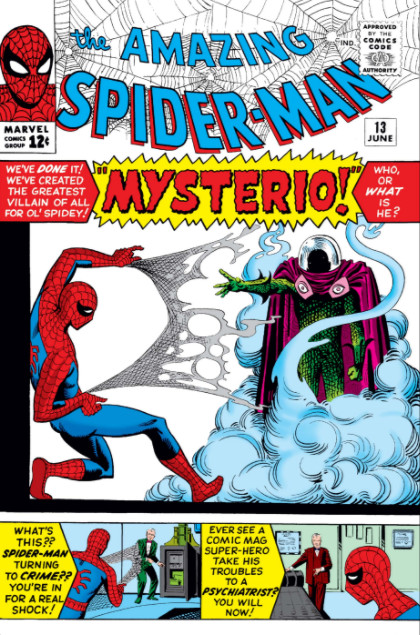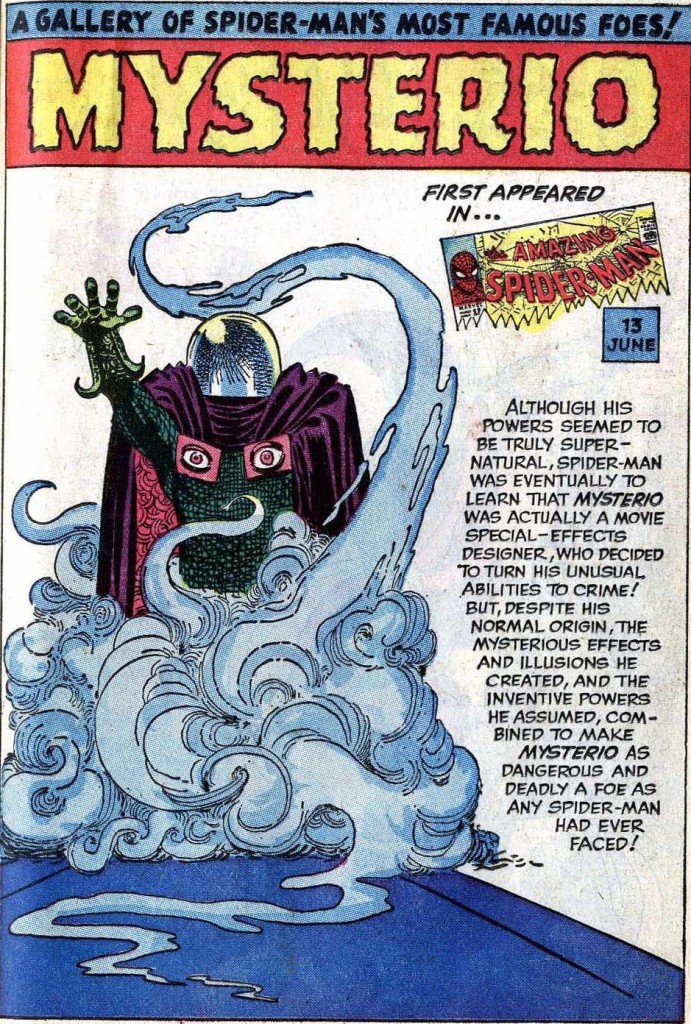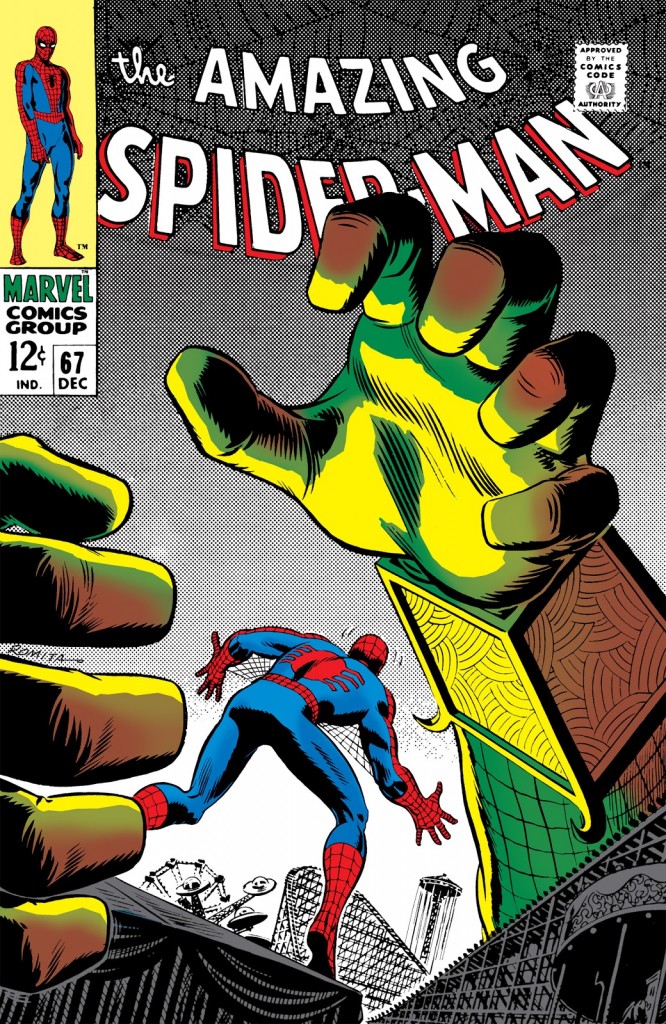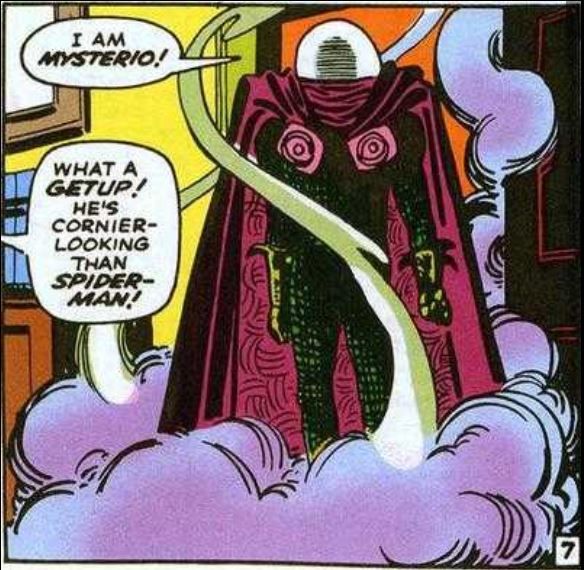Who Is Mysterio? The Early Days of the Spider-Man Villain with the Fishbowl on His Head
News dropped on Monday that actor Jake Gyllenhaal will likely play the part of Mysterio in the sequel to Spider-Man: Homecoming, whatever it’s called. (Spider-Man: Back from the Ashes would work.) Gyllenhaal is an excellent choice to play a whole range of Spidey villains — the actor’s earned trust on that front thanks to his performance in Nightcrawler. But the real news for me is Mysterio, regardless of who’s putting on the mesh green outfit with eye-brooch accessories. He’s a Spider-Man villain overdue for the big screen treatment.
(Oh, and we now know for certain that Michael Keaton will return as the Vulture, probably to stoke the fires about the Sinister Six getting together. Bokeem Woodbine’s Shocker is still alive, and it looks like Scorpion is in play as well. Only two more slots to fill! Maybe Kraven the Hunter and … The Kangaroo? I hope it’s the Kangaroo.)
So who is this Mysterio bloke? Short version: he’s a special effects wizard who decided to go into a life of crime and put a fishbowl on his head. Because comic books. He doesn’t have superpowers, but he can put on a helluva light and illusion show and he specializes in reality-bending tricks and mind games, making him an ideal movie bad guy.
 When it comes to Spider-Man, my era is the original Stan Lee-Steve Ditko run from Amazing Spider-Man #1–#38 (1963–1966). I wasn’t alive at the time; the first Spider-Man I knew was the one on The Electric Company. But when I read the entire run in the Marvel Essentials volumes, I understood why the Lee-Ditko Spider-Man is considered a high point of the Silver Age of comics. The teen drama of Peter Parker and Spidey’s wisecrackery brought out the best in Lee’s writing. Ditko’s energetic art style was a marvel of physical pacing, and nobody could wring anxiety and panic from a character’s facial expressions better than he could.
When it comes to Spider-Man, my era is the original Stan Lee-Steve Ditko run from Amazing Spider-Man #1–#38 (1963–1966). I wasn’t alive at the time; the first Spider-Man I knew was the one on The Electric Company. But when I read the entire run in the Marvel Essentials volumes, I understood why the Lee-Ditko Spider-Man is considered a high point of the Silver Age of comics. The teen drama of Peter Parker and Spidey’s wisecrackery brought out the best in Lee’s writing. Ditko’s energetic art style was a marvel of physical pacing, and nobody could wring anxiety and panic from a character’s facial expressions better than he could.
During this period, Stan and Steve cranked out classic villains. To give you an idea of how fast the memorable bad guys were popping off the page, by the time Mysterio appeared in Amazing Spider-Man #13 in June 1964, the comic had already featured the Vulture (twice), Doctor Octopus (twice), the Sandman, the Lizard, Electro, and the Enforcers, with time for Doctor Doom to swing over from The Fantastic Four to do a guest-villain spot. The next two issues would introduce the Green Goblin and Kraven the Hunter. That’s, well, an amazing run right there.
Mysterio is classic Lee-Ditko all the way. You’ve got a silly high-concept from Lee that avoids the “scientist makes himself into a monster” or “cheap crook gets powers and becomes a powerful cheap crook” clichés and allows Ditko to indulge in weird visuals. Mysterio gives a new latitude to Spidey stories since he cannot take on Spider-Man physically and must rely on careful planning with a range of optical illusions, robotics, hypnotism, projections, sets, Spider-Sense jamming sonar, and other stage magic trickery. The best Mysterio stories follow a Mission: Impossible template where Mr. Fishbowl uses misdirection and complex deceptions to make Spider-Man or the public perceive a warped reality.
The character design is fantastic, like that for most of Ditko’s villains. Mysterio can work without his green and purple costume — one of his classic appearances never shows him in his outfit — but the look is one of those instantly iconic ones that artists like Ditko and Jack Kirby were creating on a monthly basis in the Silver Age. The opaque fishbowl helmet (which is supposed to suggest a crystal ball, but even J. Jonah Jameson calls it a fishbowl as soon as Mysterio first materializes) makes an immediate impression. But I think it’s the creepy eye brooches holding up the patterned cape that make Mysterio look truly bizarre. The eyes create the suggestion of a face, but a face that isn’t in the right place. The look is eldritch, befitting Doctor Strange’s world — except the character is a trickster, not a master of mystic arts.
 Typical of Silver Age characters, Mysterio didn’t receive a fully developed background in his early years, only the sketches of one. We didn’t find out his real name, Quentin Beck, until over a decade later. He started out working as a stuntman in Hollywood, and then he became a special effects wizard, building prop monsters, costumes, and sets. Apparently, he wanted to be an actor, but in typical villain style decided to take a criminal route to quick success when he felt he wasn’t receiving his deserved recognition. His plan: publicly defeat a superhero. Mysterio picked Spider-Man because the other options in the Marvel Universe at the time were the Avengers and the Fantastic Four. Spidey, already under a wave a bad publicity, must have seemed the easiest mark.
Typical of Silver Age characters, Mysterio didn’t receive a fully developed background in his early years, only the sketches of one. We didn’t find out his real name, Quentin Beck, until over a decade later. He started out working as a stuntman in Hollywood, and then he became a special effects wizard, building prop monsters, costumes, and sets. Apparently, he wanted to be an actor, but in typical villain style decided to take a criminal route to quick success when he felt he wasn’t receiving his deserved recognition. His plan: publicly defeat a superhero. Mysterio picked Spider-Man because the other options in the Marvel Universe at the time were the Avengers and the Fantastic Four. Spidey, already under a wave a bad publicity, must have seemed the easiest mark.
This leads into The Amazing Spider-Man #13, “The Menace of … Mysterio!” With usual Barnum hoopla, the cover proclaims “We’ve done it! We’ve created the greatest villain of all for ol’ Spider!” The cover also brushes up Marvel’s credentials as the House of Ideas by showing Spider-Man taking his troubles to a psychiatrist. The actual psychiatric visit in the comic only takes up three panels, but there’s no question that Spider-Man was covering new ground in the superhero set.
The story has Mysterio posing as Spider-Man to commit petty crimes so he can trick the hero into thinking he’s gone over the edge. As Mysterio, he appears in a puff of smoke in the Daily Bugle offices to offer to defeat Spider-Man if J. Jonah Jameson puts a notice in the Bugle challenging the web-slinger to meet him on the Brooklyn Bridge. Mysterio appears to best Spider-Man using his astonishing powers of vanishing in sudden smoke plumes generated from his boots and magnetizing himself to … bricks? The real killer gizmos are his Spider-Sense jamming radar and special acid that dissolves the hero’s webbing.
But Spidey uses one of his tracers to follow Mysterio to his lair — a TV studio of course — where he defeats bowl-head in the middle of the shooting of a science fiction show. It’s appropriately nuts. During the fight, Mysterio takes up panel time to explain his history in special effects and provide what little we’d know of his backstory for many years. He forgets to mention his name when bragging about himself.
Mysterio’s next chronological appearance was as a member of the first iteration of the Sinister Six in the Amazing Spider-Man Annual #1. Mysterio joined Doctor Octopus, Electro, Kraven the Hunter, the Sandman, and the Vulture in a ploy to defeat Spidey. Mysterio’s gimmick was robots of three of the X-Men — Beast, Angel, and Cyclops — which Spider-Man easily trounced. Like the other members of the Sinister Six, Mysterio has a magnificently illustrated splash page as Spider-Man wallops him.
 When Mysterio returned to The Amazing Spider-Man for issue #24 (“Spider-Man Goes Mad!”), he dropped the costume in favor of pretending to be a psychiatrist, Dr. Ludwig Rinehart. I think Stan Lee latched onto the moment from issue #13 where Spidey visited the psychiatrist and he wanted to explore that scene further. Rinehart goes to the Daily Bugle with a theory that Spider-Man has a split personality and is close to snapping. J.J., of course, runs with it. Using various illusions, Mysterio makes Spider-Man believe he might really be cracking up, which sends him running to Dr. Rinehart as the only person who may understand. Mysterio uses a funhouse of weird tricks, like building an upside-down room, to convince Spidey he’s flying off the edge. But J.J. and Flash Thompson come charging in to mess up Mysterio’s plan right as he’s on the verge of coaxing Spidey’ secret identity out of him. Ditko has a great time illustrating the heightened psychological tension and oddball visuals.
When Mysterio returned to The Amazing Spider-Man for issue #24 (“Spider-Man Goes Mad!”), he dropped the costume in favor of pretending to be a psychiatrist, Dr. Ludwig Rinehart. I think Stan Lee latched onto the moment from issue #13 where Spidey visited the psychiatrist and he wanted to explore that scene further. Rinehart goes to the Daily Bugle with a theory that Spider-Man has a split personality and is close to snapping. J.J., of course, runs with it. Using various illusions, Mysterio makes Spider-Man believe he might really be cracking up, which sends him running to Dr. Rinehart as the only person who may understand. Mysterio uses a funhouse of weird tricks, like building an upside-down room, to convince Spidey he’s flying off the edge. But J.J. and Flash Thompson come charging in to mess up Mysterio’s plan right as he’s on the verge of coaxing Spidey’ secret identity out of him. Ditko has a great time illustrating the heightened psychological tension and oddball visuals.
My favorite Mysterio story from the Silver Age comes from 1968. Ditko was gone from both the comic and Marvel, and John Romita was now handling the artwork. In The Amazing Spider-Man #66–67 (“The Madness of Mysterio!”, “To Squash a Spider!”), Mysterio puts his most ambitious plan yet into action: make himself into a kaiju! By this point in the comics, Mysterio’s motivation had changed into the conventional one for Spidey villains: revenge for all those humiliating defeats. Mysterio lures his foe into an old TV studio and uses post-hypnotic suggestion — or something like that, it’s hazy — to make Spider-Man believe he’s only six inches tall and trapped on the model of an amusement park. Spidey runs through a series of traps while a giant Mysterio chases him, hoping to break the web-slinger’s mind.
These two issues are the apex of Classic Era Mysterio, where his special effects background gets put to the best use. His plan hinges on building a model stage for a monster movie and making Spider-Man imagine he’s the poor sap fleeing from the monster. Essentially, Mysterio does his old Hollywood special effects job of making someone believe in a giant monster through the art of model building, mirror tricks (there’s a trap in a hall of mirrors), and relying on the viewer’s willingness to believe. Romita’s artwork is superb at creating the scale between Spidey and Kaiju-Mysterio, and even if the wrap-up barely explains how all this happened, it’s quintessential Silver Age good times.
Anyway, thanks for the excuse to re-read my old Essential Spider Man volumes. I won’t make any predictions about how the MCU will bring Mysterio to life, but I wouldn’t mind them using the “giant monster” trick from ASM #66–67. The next Spider-Man film arrives July 5, 2019, only a few months after the events of the currently untitled sequel to Avengers: Infinity War resets and reconfigures the MCU into whatever it’s going to be. Maybe the new Spider-Man movie will finally get around to including J. Jonah Jameson, who’s been weirdly absent during the last three films. Yes, I know J. K. Simmons is a difficult actor to replace. So maybe they could just cast … J. K. Simmons?
Ryan Harvey is one of the original bloggers for Black Gate, starting in 2008. He received the Writers of the Future Award for his short story “An Acolyte of Black Spires,” and his stories “The Sorrowless Thief” and “Stand at Dubun-Geb” are available in Black Gate online fiction. A further Ahn-Tarqa adventure, “Farewell to Tyrn”, is available as an e-book. His most recent publication, “The Invasion Will Be Alphabetized,” is now on sale in Stupendous Stories #19. Ryan lives in Costa Mesa, California where he works as a marketing writer. Occasionally, people ask him to talk about Edgar Rice Burroughs or Godzilla in interviews.

Mysterio has always been a fantastic villain who’s been unfairly maligned because dumb fans took the “He’s got a fishbowl for a head!” line way too literally, and I think Kevin Smith even killed him off a few years back because he assumed no one would miss such a “lame” character (needless to say, Smith is a very bad writer). Anyway, Mysterio is a natural fit for a movie version.
Nice one!
Marvel and DC compete by imitating each other, so most Super Heroes and Villains had mirrors in each comics world – these then helped solidify cliché tropes.
The important thing is that Marvel under Stan Lee was really good at dipping into popular culture and trends. The Hulk was powered by Gamma rays through lingering nuclear fears. The same for X-Men and Spider Man’s Radioactive spider bite – modern atomic testing added radiation to the atmosphere expanding mutations, some had super powers. Ridiculous but at the edge of “Suspension of Disbelief” so under good writers and artists could be ran with and they sure did.
Stan Lee actually noted – in response to some issues with recent movies – “If I wrote them today I’d use Genetic Engineering. We had no idea it’d be anywhere near as possible as it is today back then. Centuries at best. I’m amazed” (best I remember so not exact quote)
The reason I typed on this is that Mysterio was big on using “Holograms” because that was a big thing then. Disney had pioneered it with the Haunted Mansion stuff and other tech was using it. Scifi writers imagined that when computers got better perhaps ‘interactive holograms’ could be made. And – RIP Atari – they actually were working on a game system – first a handheld then a home system that would do 3d games. Imagine blocky 70s/80s games but in 3d for real… On home and handheld consoles.
So – Mysterio – being a “Special Effects Wizard” turned criminal – made high use of Holograms, later even making “Solid Holograms”… Like any Antimatter for anywhere near enough energy to do that, Myst? Why not just blackmail the world – or supply its energy to get super rich, no need for crime. But, its comics, and fun…
I read the Ditko/Lee spiderman for the first time last year. I love the Mysterio costume design and Ditko’s art. But the actual character never really did anything for me.
I know it’s comic book land but I had a hard time believing someone as smart as Peter Parker was falling for movie props.
Especially when you compare it to the Doc Ock issues that culminate in 31-33.
It should be easier to cast J. K. Simmons these days, even with all his Farmers Insurance commercial work, seeing as we now have 2 of him (courtesy of the Starz series, Counterpart)!